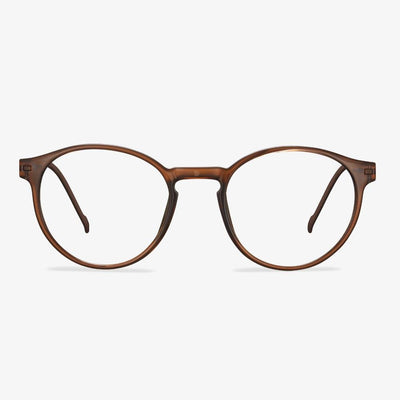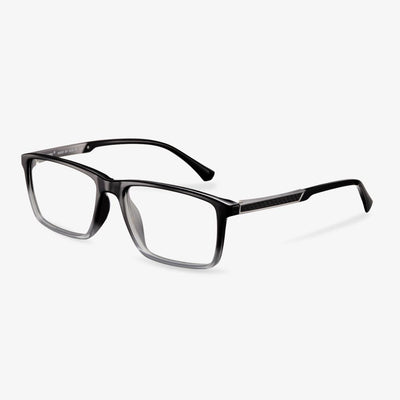There are three processes for resin-changing lenses.
The incorporation method, known as bulk polymerization, is similar to the method of glass lens, that is, one or more photochromic dyes are directly incorporated into the polymer monomer of the substrate for bulk polymerization, and the lens formed after curing will change color. Discoloration dye is completely integrated into the resin lens substrate, so the lens made of color persistence is very good.
The uniformity of discoloration and the depth of color after discoloration are highly related to the thickness of the lens. Because the thickness of the lenses at all levels is different, there will be a color difference between the depth of discoloration and the uniformity, and the uneven phenomenon of high brightness is more obvious.
The film type is known as the coating method. It is the chromatic resin lens by coating or dipping in a layer of chromatic dye on the base of the resin lens. Because the coating covers the surface of the lens, the color uniformity is good. The coating, which is only about 0.05mm thick, does not provide enough molecules to make the lens dark enough, so the color is relatively less dark, and the discoloration lasts slightly longer.
Infiltration, known as the penetration method, is to use the principle of penetration, through the thermal diffusion method to make the color dye permeate the surface of the resin lens sheet material, with diffusion depth up to 0.15~0.20mm. The lens has a constant color change characteristic. There will be no inconsistency between the center and the surrounding color as the luminosity gets darker. The color-changing resin lens made by infiltration type has the benefits of uniform color-changing, small color difference, fast and thorough color-fading, which is the mainstream of color-changing technology at present.
Can you get your new eyeglasses in a day online?
Yes, it is possible to have an eye exam and prescription glasses on the same day. But unless it's an emergency, you'd better wait a few days and then buy the best glasses you need. Not all glasses are available within an hour or on the day of your eye exam.
How long will the titanium frame last?
Titanium and titanium alloys are often used to make the most durable frames. Their strength is comparable to that of stainless steel. Medical facilities use titanium to make medical implants such as heart valves, showing just how durable the metal can be in extreme environments. Look at the maintenance between quality and use. Good glasses electroplating after three processes, the first is in the glasses or pure raw materials, plating a layer of an adhesion layer, used to attach the plating color layer. The second is the electroplating color layer. The third one is that after the electroplating color layer, another layer of electroplating protection is transparent. The electroplating of glasses through three processes can ensure that the glasses are not easy to lose color and damage in about 5 years. Now the glasses electroplating basically omits the processing of the last layer of the color protective layer, so the service life is about 3 years.
Geometric Cat-Eye glasses
Geometric cat-eye glasses are a big trend this year. They accentuate the personality and the shape of your face. If you have a square face, a geometric cat-eye frame will add some angle to your face, which can be very flattering. Cat-eye frames are both sexy and serious, drawing the image of a determined woman who knows what she wants. Choose the modern contours of Treble. Retro cat-eye black frames are a great option for women working in a business setting, as they give you a smart and mysterious look that is sure to emphasize your professionalism.
The design evolution of progressive lenses
Spherical and aspheric designs
The design of the front surface of the far-use area of the early progressive lens is similar to that of the ordinary spherical single vision lenses, so it is called a spherical progressive lens. Since 1974, the front surface of the far-use region of the lens is designed to be aspheric by designers, which not only reduces the peripheral aberration but makes the lens thinner, lighter, and less powerful.
Hard and soft design
For hard design, the channel is short, and the gradient is large. The near-use area position is high. The effective visual area of remote and near-use areas was larger. Peripheral astigmatism is relatively concentrated. Because surrounding astigmatism increases rapidly and the distribution is dense, the curve effect is more obvious. The gradient area is narrow. It is more difficult and takes longer for wearers to adapt.
Lenses with soft designs have slower gradients, longer gradients, and wider gradients. The angle of rotation of the eye from the far area to the near area is greater. It's easier to get used to. Compared with the hard design, the effective visual area of the far and near use areas is smaller, and the location of the near use area is lower.
Single, diverse, and individualized design
Initially, the progressive lenses used a single design, in which each basic curve was scaled equally and a luminosity combination was added within the range of its semi-finished lens blanks. The steepest base curve uses the same lens design as the flattest base curve. Lenses designers quickly realized that the overall performance of the lens could be improved by microcustomizing the lens design, leading to progressive lenses with multiple designs. This kind of design is called diverse design. By the mid-1990s, there was the emergence of individualized lens designs. In addition to using different gradients, these first individualized lens designs used steeper baseline curves with a slightly larger approach area to compensate for increased magnification and reduced field of view.
Symmetrical and asymmetric design
There is no difference between the left and right eyes in the symmetrical design of progressive lenses. As the eyes turn inward when they see near objects, the gradual gradient area gradually tilts to the nasal side from top to bottom, so the left/right progressive lenses should be rotated clockwise/counterclockwise respectively during processing. An asymptotic lens with left and right eye divisions is called an asymmetric design. The gradient is gradually and moderately inclined to the nasal side from top to bottom. The refractive force, astigmatism, and vertical prism of the two sides of the left and right gradient of the asymmetric design lenses are basically similar. At the same time, considering the characteristics of eye movement parameters in binocular vision, the peripheral aberrations of the corresponding positions of the left and right lenses were appropriately balanced to improve the visual effect of the wearer.
What Are Progressive Lenses?
Traditional eyeglasses are usually single vision lenses with one prescription. Progressive lenses are multiple with three prescriptions in a pair of eyeglasses. Progressive lenses let you see comfortably at different distances, allowing you to see close, near, and far without changing your glasses. There are other kinds of multifocal lenses like bifocals and trifocals, but progressive lenses differ because of their smooth transition between prescriptions.
Bifocals and trifocals work similarly to progressive lenses and feature either two or three prescriptions in a pair of glasses. These lenses have definitive lines separating the prescriptions. However, progressive lenses don’t use these lines and allow you to easily transition between prescriptions.
Hence, in the following section, we will show you 6 different types of progressive lenses.
Note the ratio of the lens to the face.
Usually, the vertical length of the lens of longer glasses can have a visual effect of reducing the proportion of the face. In addition, in the selection of the glasses, you should pay attention to the distance between the end of the eye and the glasses so the best ratio is that the eye is in the middle of the glasses.











































